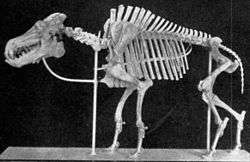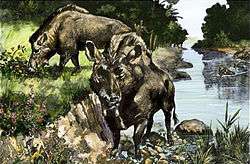Entelodont
| Entelodonts Temporal range: 37.2–16.3 Ma | |
|---|---|
 | |
| Daeodon skeleton | |
| Scientific classification | |
| Kingdom: | Animalia |
| Phylum: | Chordata |
| Class: | Mammalia |
| Order: | Artiodactyla |
| Clade: | Cetancodontamorpha [2] |
| Family: | †Entelodontidae Lydekker, 1883 |
| Genera | |
| Synonyms | |
| |
Entelodonts — sometimes facetiously termed hell pigs or terminator pigs[3] — are an extinct family of pig-like omnivores of the forests and plains of North America, Europe, and Asia from the middle Eocene[1][4] to early Miocene epochs (37.2—16.3 million years ago), existing for about 21 million years.[5]
Taxonomy

The Entelodontidae were named by Richard Lydekker and assigned to Nonruminantia by Gregory (1910).[6] They were then assigned to Artiodactyla by Lucas et al.[7] (1998) and to Entelodontoidea by Carroll (1988) and Boisserie et al. (2005). While entelodonts have long been classified as members of the Suina, Spaulding et al. have found them to be closer to whales and hippos than to pigs.[8]
Description
Entelodonts are an extinct group of rather pig-like omnivorous mammals with bulky bodies, but short, slender legs, and long muzzles. The largest were the North American Daeodon shoshonensis, and the Eurasian Paraentelodon intermedium, standing up to 2.1 m (6.9 ft) tall at the shoulder, with brains the size of an orange.[lower-alpha 1]
A single specimen recorded by M. Mendoza, C. M. Janis, and P. Palmqvist for body mass was estimated to have a weight of 421 kg (930 lb).[9]
Entelodonts had full sets of teeth, including large canines, heavy incisors, and relatively simple, yet powerful, molars. These features suggest an omnivorous diet, similar to that of modern pigs. Like many other artiodactyls, they had cloven hooves, with two toes touching the ground, and the remaining two being vestigial.[10]
The most distinguishing characteristic of the animals, however, would have been the heavy, bony lumps on either side of their heads, which are similar to a warthog's. Some of these may have been attachment points for powerful jaw muscles,[10][11] but some were larger in males, suggesting they may have fought over mates.[12]
Paleobiology

Entelodonts lived in the forests and plains where they were the apex predators in Eurasia from the late Eocene until the Oligocene, and in North America from the Late Eocene until the Early Miocene, consuming carrion and live animals and rounding off their diets with plants and tubers. They would have hunted large animals, like the cow-sized artiodactyl Eporeodon major and the sheep-sized cameloid Poebrotherium wilsoni, dispatching them with a bite from their jaws. Some fossil remains of these other animals have been found with the bite marks of entelodonts on them. Like modern-day pigs, they were omnivores, eating both meat and plants, but their adaptations show a bias towards live prey and carrion. They were most likely opportunists, mainly eating live animals, but not rejecting carrion and roots and tubers in times of drought. Some entelodonts even exhibited caching behavior, as is shown in a discovered Archaeotherium's cache, which contained the remains of several early camels.
In popular culture
Entelodonts appear in the third episode of the popular BBC documentary Walking with Beasts, where, in the program, the narrator always refers to the creatures as "entelodonts" rather than a more specific genus, such as Entelodon or Archaeotherium. The same creatures appear in another BBC production, the 2001 remake of The Lost World.
Entelodonts were also the main focus of episode 4 of National Geographic Channel's show Prehistoric Predators in an episode titled "Killer Pig". The episode featured Archaeotherium (identified as "entelodont") as being the top predator of the American Badlands, and how it evolved into the even larger Daeodon ("Dinohyus").
References
Notes
- 1 2 I. A. Vislobokova.The oldest representative of Entelodontoidea (Artiodactyla, Suiformes) from the Middle Eocene of Khaichin Ula II, Mongolia, and some evolutionary features of this superfamily Paleontological Institute, Russian Academy of Sciences, Profsoyuznaya ul. 123, Moscow, 117997, Russia
- ↑ Spaulding, Michelle; O'Leary, Maureen A.; Gatesy, John (2009). Farke, Andrew Allen, ed. "Relationships of Cetacea (Artiodactyla) Among Mammals: Increased Taxon Sampling Alters Interpretations of Key Fossils and Character Evolution". PLoS ONE. 4 (9): e7062. doi:10.1371/journal.pone.0007062. PMC 2740860
 . PMID 19774069.
. PMID 19774069. - ↑ Adrienne Mayor Fossil Legends of the First Americans. Princeton University Press, 2005. p. 213
- ↑ Vislobokova, I. A. (12 November 2008). "The oldest representative of Entelodontoidea (Artiodactyla, Suiformes) from the Middle Eocene of Khaichin Ula II, Mongolia, and some evolutionary features of this superfamily". Paleontological Journal. pp. 643–654. doi:10.1134/S0031030108060105.
- ↑ PaleoBiology Database: Entelodonts, basic info
- ↑ W. K. Gregory. 1910. The orders of mammals. Bulletin of the American Museum of Natural History 27:1-524
- ↑ S. G. Lucas, R. J. Emry, and S. E. Foss. 1998. Taxonomy and distribution of Daeodon, an Oligocene-Miocene entelodont (Mammalia: Artiodactyla) from North America. Proceedings of the Biological Society of Washington 111(2):425-435
- ↑ "Relationships of Cetacea (Artiodactyla) among mammals: increased taxon sampling alters interpretations of key fossils and character evolution". PLoS ONE. 4 (9): e7062. 2009. doi:10.1371/journal.pone.0007062. PMC 2740860
 . PMID 19774069.
. PMID 19774069. - ↑ M. Mendoza, C. M. Janis, and P. Palmqvist. 2006. Estimating the body mass of extinct ungulates: a study on the use of multiple regression. Journal of Zoology 270.
- 1 2 Savage, RJG & Long, MR (1986). Mammal Evolution: an illustrated guide. New York: Facts on File. pp. 209–210. ISBN 0-8160-1194-X.
- ↑ Palmer, D., ed. (1999). The Marshall Illustrated Encyclopedia of Dinosaurs and Prehistoric Animals. London: Marshall Editions. p. 267. ISBN 1-84028-152-9.
- ↑ "Entelodont General Evidence". BBC Worldwide. 2002. Archived from the original on March 12, 2007. Retrieved 2007-11-21.
External links
- "http://www.abc.net.au/beasts/factfiles/entelodont.htm". Video, images & sound. External link in
|title=(help) - "Museum display of Entelodont skeleton :: Geoscience Slides". digital.lib.uiowa.edu. Entelodont Skeleton.